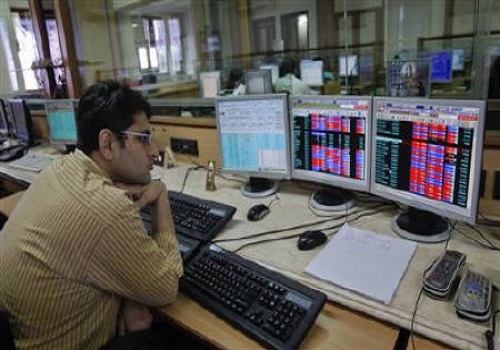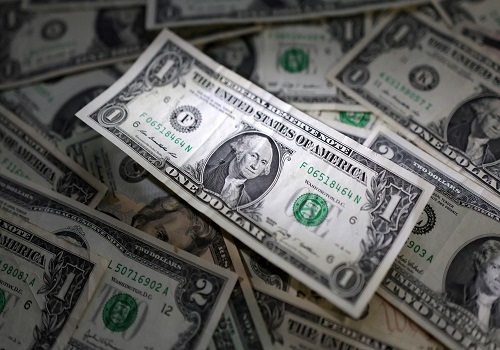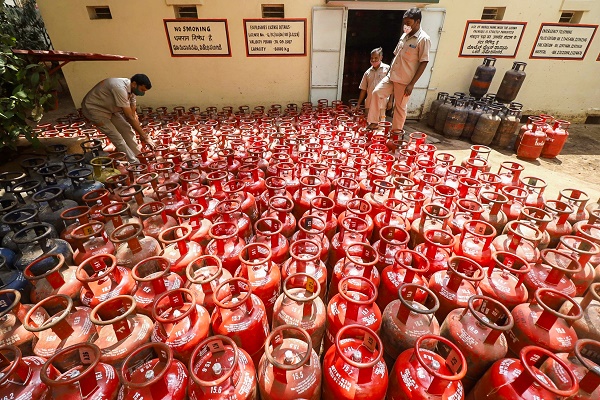Jeera trading range for the day is 20590-21670 - Kedia Advisory

Gold
Gold prices declined by 0.79% to settle at 85,196 as a stronger U.S. dollar and anticipation of key inflation data weighed on investor sentiment. Uncertainty surrounding U.S. trade policies also influenced the market, with President Donald Trump considering a 25% "reciprocal" tariff on European autos and delaying new tariffs on Mexican and Canadian imports until April 2. Meanwhile, weak U.S. economic data has reinforced expectations of accelerated rate cuts, which could support gold in the longer term. China’s total gold imports via Hong Kong dropped 44.8% in January compared to December, reflecting subdued demand. However, China’s central bank increased its gold reserves for the third consecutive month, lifting its official holdings to 2,285 metric tons. Goldman Sachs raised its end-2025 gold price forecast to $3,100 per ounce, citing structurally higher central bank demand. The London Bullion Market Association (LBMA) reported that gold held in London vaults declined by 1.7% in January. Physical gold demand remained weak in key markets like India and China due to record-high prices. Indian dealers increased discounts to $35 per ounce, while Chinese gold was sold at a discount of $1-$3 per ounce. Gold exports from Switzerland to India and China plummeted by 88% and 99%, respectively. Technically, gold is experiencing long liquidation, with open interest dropping by 3.58% to 15,115. Immediate support is at 84,785, with a potential test of 84,375, while resistance stands at 85,700, and a break above could push prices to 86,205.
Trading Ideas:
* Gold trading range for the day is 84375-86205.
* Gold prices fell as the U.S. dollar firmed, while investors awaited a key inflation print.
* U.S. President Trump raised hopes for another month-long pause on steep new tariffs on imports from Mexico and Canada.
* Recent weak US data has reinforced expectations of accelerated rate cuts.
Silver
Silver prices declined by 1.03% to settle at 95,550 as the U.S. dollar strengthened, reaching a one-week high, supported by strong economic data. U.S. durable goods orders surged 3.1% in January, exceeding the expected 2% increase, while Q4 GDP growth slowed to 2.3% from 3.1% in Q3. Labor market data showed mixed signals, with initial jobless claims rising to a two-month high while continuing claims declined. Meanwhile, trade tensions escalated as President Trump confirmed a 25% tariff on imports from Canada and Mexico, along with additional tariffs on China and the EU. On the supply side, Hecla Mining Company reported a 13% rise in silver production for 2024, reaching 16.2 million ounces, marking its second-highest output in history. However, U.S. silver coin purchases in January dropped 27% year-on-year, the weakest demand for January since 2018. The London Bullion Market Association (LBMA) reported an 8.6% decline in silver held in London vaults, the steepest monthly drop on record. Global silver demand is expected to remain stable at 1.2 billion ounces in 2025, with industrial fabrication projected to reach a record 700 million ounces, driven by green energy applications. Investment demand is forecasted to rise by 3%, while jewelry demand is expected to decline by 6%, mainly due to high local prices in India. Technically, the silver market is under fresh selling pressure, with open interest increasing by 15.71% to 19,285 while prices declined by 993 rupees. Immediate support is at 94,900, with further downside potential to 94,255, while resistance is seen at 96,340, and a break above could push prices toward 97,135.
Trading Ideas:
* Silver trading range for the day is 94255-97135.
* Silver dropped as dollar rose, the highest in one week, supported by signs of a resilient US economy.
* Durable goods orders increased 3.1% in January, the largest gain in six months.
* Trade concerns grew after US President Trump confirmed that 25% tariffs on Canada and Mexico will take effect next week.
Crude Oil
Crude oil prices surged by 2.25% to settle at 6,135 as supply concerns intensified following U.S. President Donald Trump's decision to revoke Chevron's license to operate in Venezuela. This move effectively blocks the export of 240,000 barrels per day (bpd) of Venezuelan crude, further tightening global supplies. However, gains were partially offset by reports of a possible peace deal in Ukraine, which could increase Russian oil exports, along with an unexpected rise in U.S. gasoline and distillate stocks. According to the American Petroleum Institute (API), U.S. crude inventories dropped by 640,000 barrels in the week ending February 21, while data from the Energy Information Administration (EIA) showed a larger decline of 2.332 million barrels against market expectations of a 2.54 million barrel build. In contrast, crude stocks at Cushing, Oklahoma, rose by 1.282 million barrels, while gasoline and distillate inventories climbed by 0.369 million and 3.908 million barrels, respectively. Meanwhile, the EIA revised its crude oil production forecast higher, expecting U.S. output to reach 13.59 million bpd in 2025, up from 13.55 million bpd in previous estimates. Despite U.S. President Trump's push to maximize oil production, energy firms remain cautious, prioritizing capital discipline over aggressive growth. Technically, the market is witnessing short covering, as evidenced by a sharp 27.84% drop in open interest to 3,644 while prices rose by 135 rupees. Immediate support is at 6,034, with further downside potential to 5,933, while resistance is seen at 6,201, and a breakout above could push prices toward 6,267.
Trading Ideas:
* Crudeoil trading range for the day is 5933-6267.
* Crude oil rose as supply concerns resurfaced after U.S. President Trump's revoked a licence granted to Chevron to operate in Venezuela.
* Gains were capped, however, by signs of a potential peace deal in Ukraine, which could result in higher Russian oil flows.
* Chevron exports about 240,000 bpd of crude from its Venezuela operations, more than a quarter of the country's entire oil output.
Natural Gas
Natural gas prices declined by 0.57% to settle at 347.7, pressured by near-record output, mild weather conditions, and reduced heating demand forecasts for the next two weeks. Despite the price drop, record gas flows to liquefied natural gas (LNG) export plants provided some support. Data from LSEG showed that average gas output in the Lower 48 U.S. states increased to 104.6 billion cubic feet per day (bcfd) in February, matching the record set in December 2023. Output fluctuated over the past few weeks, hitting a three-week low of 100.5 bcfd on February 19 due to extreme cold before rebounding to 105.2 bcfd on February 27 as milder temperatures allowed wells to recover. Meteorologists predict that weather in the Lower 48 states will remain warmer than usual through mid-March, contributing to weaker demand. As a result, LSEG forecasts total gas demand, including exports, to decline from 125.8 bcfd this week to 117.4 bcfd next week. Meanwhile, LNG exports remain strong, with flows to major U.S. export terminals averaging 15.6 bcfd in February, surpassing the previous monthly record of 14.7 bcfd set in December 2023. Technically, the market is under fresh selling pressure, as indicated by a 4.25% rise in open interest to 17,287 while prices dropped by 2 rupees. Natural gas is finding support at 338.9, with a potential decline to 330.2, while resistance is seen at 355.8, and a breakout above could push prices toward 364.
Trading Ideas:
* Naturalgas trading range for the day is 330.2-364.
* Natural gas eased on near record output, mild weather and forecast for less heating demand.
* US utilities withdrew 261 billion cubic feet (bcf) of natural gas from storage
* Mild weather allows frozen wells to return to service
Copper
Copper prices edged up by 0.02% to settle at 864.45, supported by supply concerns despite abundant stock levels in China. Copper inventories in China have surged to over 260,000 tonnes, tripling from the start of the year, while bonded stocks have also doubled to 33,000 tonnes. However, geopolitical developments have added uncertainty to the market. U.S. President Donald Trump has initiated an investigation into potential tariffs on copper imports, aiming to boost domestic production and counter China’s growing dominance in the sector. Supply-side disruptions also influenced sentiment, with Escondida - the world’s largest copper mine - experiencing a power outage due to a massive blackout in Chile, a key copper-producing region. Meanwhile, the International Copper Study Group (ICSG) reported that the global refined copper market posted a 22,000-metric-ton deficit in December, down from 124,000 metric tons in November. However, for the full year, the market recorded a surplus of 301,000 metric tons compared to a 52,000-metric-ton deficit in the previous year. On the demand side, China’s imports of unwrought copper and copper products surged 17.8% year-on-year in December to 559,000 metric tons, while its refined copper production rose 4.3% to 1.24 million metric tons. Technically, the market is witnessing short covering, with open interest declining by 0.72% to 5,544 while prices saw a marginal increase. Copper has support at 860.8, with a potential downside to 857, while resistance is at 868.3, and a breakout could push prices toward 872.
Trading Ideas:
* Copper trading range for the day is 857-872.
* Copper settle flat as copper supply in China remains abundant, with stocks rising to over 260,000 tonnes.
* US President Trump ordered an investigation into potential tariffs on copper imports aimed at revitalizing US production of the metal.
* Copper market in 22,000 metric tons deficit in Dec 2024 – ICSG
Zinc
Zinc prices settled marginally lower by -0.02% at 268.05, erasing earlier gains as the U.S. dollar strengthened ahead of President Donald Trump’s upcoming tariff decisions. The market also reacted to rising zinc inventories in Shanghai Futures Exchange warehouses, which surged by 26.3% from the previous week. Meanwhile, the People’s Bank of China (PBoC) indicated its willingness to adjust monetary policy as needed to support economic stability, considering weak domestic demand and increasing external pressures. On the supply side, global mined zinc production fell for the third consecutive year in 2024, with a 7% drop in refined zinc output from China. The Red Dog Mine in Alaska, which accounts for 10% of global supply, is set to slow operations in 2025, contributing to supply concerns. The International Lead and Zinc Study Group (ILZSG) reported that the global zinc market swung to a 62,000-metric-ton deficit in 2024, compared to a surplus of 310,000 metric tons in the previous year, driven by lower production across key regions, including China, Japan, and South Korea. Meanwhile, demand for refined zinc remained at 13.6 million tons, as reduced usage in China, Europe, and the U.S. was balanced by higher consumption in Brazil, India, and South Korea. Technically, the market saw fresh selling pressure with a slight increase in open interest by 0.13% to 2,345. Zinc has immediate support at 266.7, with a potential decline to 265.3, while resistance is seen at 269.8, and a breakout could push prices toward 271.5.
Trading Ideas:
* Zinc trading range for the day is 265.3-271.5.
* Zinc pared all gains as dollar recovered as the deadline for President Trump’s latest tariffs draws closer.
* Zinc inventories in warehouses monitored by the Shanghai Futures Exchange rose 26.3 % from last Friday.
* PBOC said in its fourth-quarter monetary policy implementation report that it would adjust policy at the appropriate time to support the economy.
Aluminium
Aluminium prices settled higher by 0.25% at 258.75, supported by the European Union’s agreement to ban Russian primary aluminium imports as part of a fresh sanctions package. However, gains were limited as post-holiday inventory accumulation continues, with stocks expected to rise further this week. Additional pressure came from the resumption of aluminium production in China, where domestic operating capacity is gradually increasing. On the global front, aluminium premiums in the U.S. surged 25% since February 7 to 35 cents per pound, reflecting supply concerns. Meanwhile, global primary aluminium output in January increased by 2.7% year-on-year to 6.252 million tonnes, according to the International Aluminium Institute (IAI). In China, production hit a record 44 million tonnes in 2024, but with Beijing’s cap on production at 25 million tonnes set in 2017 to control excess supply and carbon emissions, future output growth is likely to slow. Aluminium stocks in LME warehouses declined to 547,950 tonnes, the lowest since May, tightening available supply. China’s exports of unwrought aluminium and aluminium products rose 17% in the first ten months of 2024, reaching nearly 5.5 million tonnes. Technically, fresh buying was observed, with open interest rising 7.01% to 3,053. Aluminium has immediate support at 257.2, with a potential test of 255.5 if the downside persists. Resistance is seen at 260.3, and a breakout could push prices towards 261.7.
Trading Ideas:
* Aluminium trading range for the day is 255.5-261.7.
* Aluminium gains as EU envoys' agreement to ban Russian primary aluminium imports in a fresh sanctions package.
* The U.S. aluminium premium over the global benchmark on LME has shot up by a quarter since February 7 to 35 cents per pound.
* Aluminium inventories in warehouses monitored by the Shanghai Futures Exchange rose 17.5%.
Cottoncandy
Cottoncandy prices declined by 0.41% to settle at 53,510 due to increased supply and weak mill buying. Mills are well-stocked, reducing their immediate purchasing needs. Brazil’s cotton production for 2024-25 is expected to rise by 1.6% to 3.7616 million tons, with a 4.8% expansion in planting area, signaling ample global supply. Additionally, the Cotton Corporation of India (CCI) is expected to procure over 100 lakh bales at the Minimum Support Price (MSP) this season. The Cotton Association of India (CAI) estimates India’s cotton output for 2024-25 at 301.75 lakh bales, down from 327.45 lakh bales in the previous season, primarily due to lower yields in Gujarat, Punjab, and Haryana. As of January 2025, total cotton supply stood at 234.26 lakh bales, including 188.07 lakh bales of fresh pressings, 16 lakh bales of imports, and an opening stock of 30.19 lakh bales. Estimated cotton consumption till January 2025 is 114 lakh bales, with exports at 8 lakh bales, while ending stocks are at 112.26 lakh bales. The CAI maintained its domestic consumption projection at 315 lakh bales, with export estimates for 2024-25 at 17 lakh bales, lower than the previous season’s 28.36 lakh bales. Technically, the market is witnessing long liquidation, with open interest remaining unchanged at 253. Prices are supported at 53,200, with a potential test at the 52800 level, while resistance is also at 53,860, and a move above could push prices to the 54200 level.
Trading Ideas:
* Cottoncandy trading range for the day is 53510-53510.
* Cotton dropped due to a substantial increase in supply and limited mill buying.
* Mills are well-stocked and are not facing immediate purchasing requirements.
* Brazil’s 2024-25 cotton production is projected to be 1.6 per cent higher at 3.7616 million tons
* In Rajkot, a major spot market, the price ended at 25576.85 Rupees dropped by -0.3 percent.
Turmeric
Turmeric prices settled slightly higher at 12,522, gaining 0.03%, as concerns over lower new crop yields provided support. Production is expected to decline by 10-15% this year, especially in the Nanded region, where small rhizomes and crop rot have impacted output. However, confirmation of the exact losses will only be possible as harvesting progresses in key producing areas. Despite an increase in turmeric acreage to 3.30 lakh hectares, up 10% from the previous season, untimely rains have reduced productivity, limiting overall production growth. Arrivals of the new turmeric crop have begun in major markets like Nizamabad and Hingoli, keeping the upside in check. Last year’s turmeric production was 10.75 lakh tonnes, and this year’s output is expected to remain similar or fluctuate by 3-5% due to lower yields in key regions. Meanwhile, exports of turmeric from April to November 2024 increased by 9.80% to 1,21,601.21 tonnes compared to the same period in 2023. However, monthly exports in November 2024 fell by 20.18% compared to October but remained 48.22% higher year-on-year. Imports surged by 101.80% during the same period, reaching 18,937.95 tonnes, though November imports dropped by 34.84% compared to October. Technically, turmeric is witnessing fresh buying, with open interest rising by 2.29% to 12,745. Prices are supported at 12,252, with a potential test at 11,984 on the downside, while resistance is seen at 12,778, and a move above this level could push prices toward 13,036.
Trading Ideas:
* Turmeric trading range for the day is 11984-13036.
* Turmeric gained as new crop yields are expected to be 10-15% lower this year.
* Support also seen amid concerns over slow growth of rhizomes and low yield estimates persist.
* However upside seen limited as arrival of new turmeric crop has started.
* In Nizamabad, a major spot market, the price ended at 12849.9 Rupees dropped by -1.71 percent.
Jeera
Jeera prices surged by 1.87% to settle at 21,245, driven by a delayed new crop arrival in Gujarat due to unfavorable weather conditions. Sowing in key states like Gujarat and Rajasthan was postponed by about a month, affecting early supplies. However, the upside remains limited as demand is currently low, and the export business is being met from existing stocks. Farmers still hold about 20 lakh bags, with only 3-4 lakh bags expected to be traded before the season ends, leaving a substantial carry-forward stock of approximately 16 lakh bags. Despite these factors, India remains the most competitive supplier of cumin in the global market. The country’s cumin seed production for 2023-24 has increased to 8.6 lakh tonnes from 11.87 lakh hectares, compared to last year’s 5.77 lakh tonnes from 9.37 lakh hectares. Indian cumin is currently priced at $3,050 per tonne, significantly cheaper than Chinese cumin, which is $200-$250 higher. This price advantage is expected to attract more international buyers, particularly from China, supporting the market in the coming months. Additionally, ongoing geopolitical tensions in the Middle East have boosted export demand from Gujarat. Jeera exports from April to November 2024 surged by 74.04% to 1,47,006.20 tonnes compared to the same period in 2023. Technically, the market is witnessing short covering, with open interest dropping by 0.9% to 2,655. Jeera has immediate support at 20,920, with a potential test at 20,590 if selling pressure increases. Resistance is seen at 21,460, and a move above this level could push prices toward 21,670.
Trading Ideas:
* Jeera trading range for the day is 20590-21670.
* Jeera gains as the start of the new crop of cumin in Gujarat has been delayed by about a month.
* However upside seen limited as demand is low and the current export business is being met from the available stock.
* The current season is expected to have similar production levels as last year due to better crop conditions and good sowing.
* In Unjha, a major spot market, the price ended at 21076.15 Rupees dropped by -0.12 percent.
Views express by all participants are for information & academic purpose only. Kindly read disclaimer before referring below views





.jpg)















